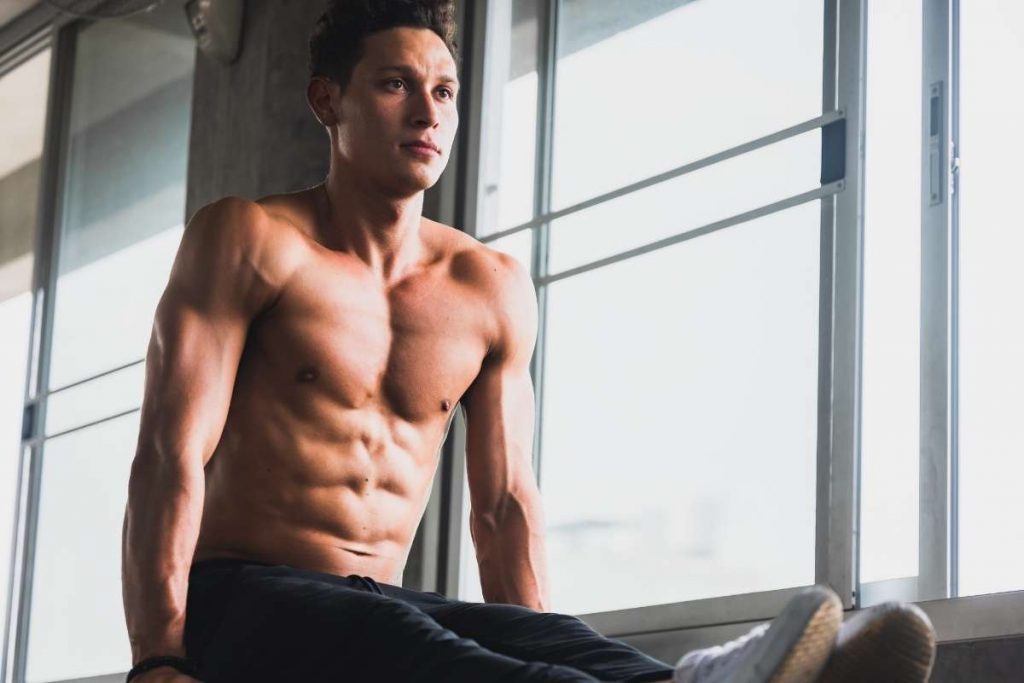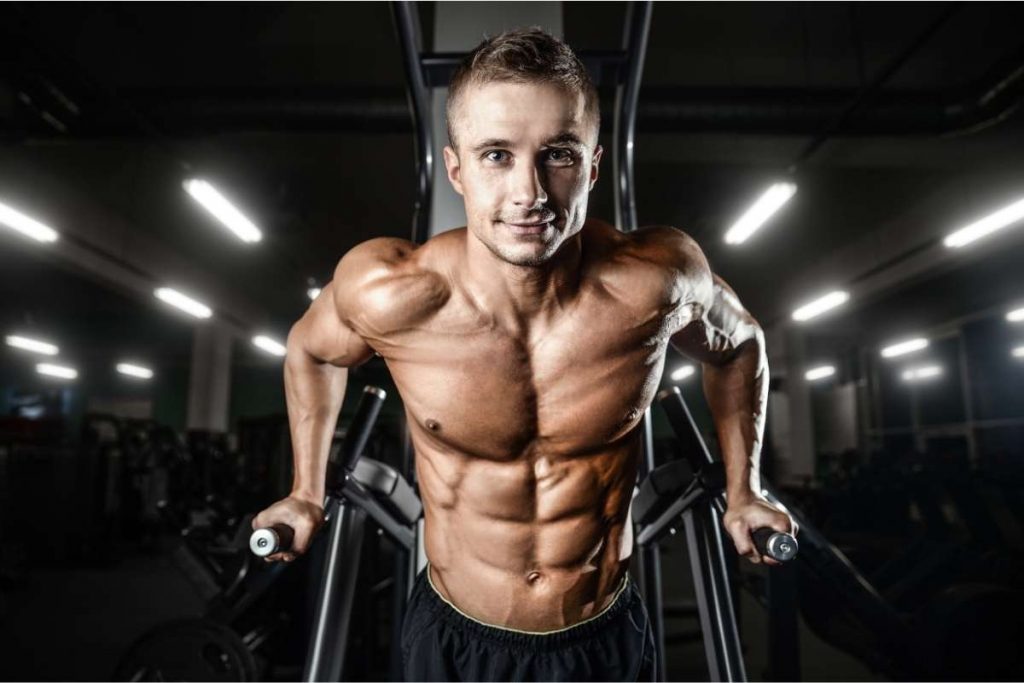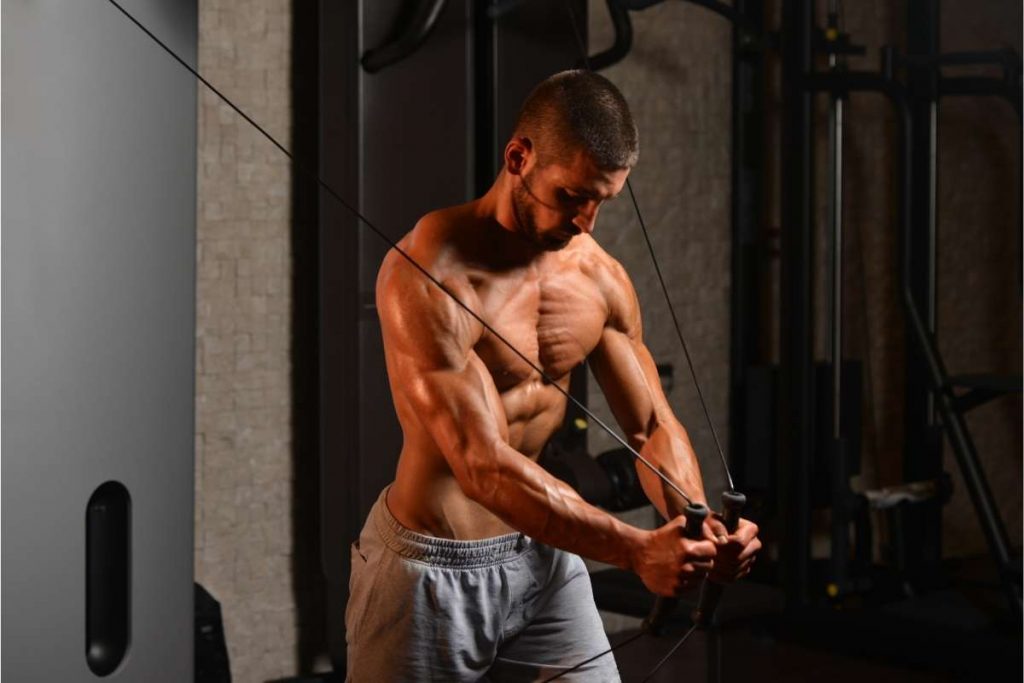What's inside
In the fitness community, Mondays are known as “international chest day.” This is just one way we can tell that the chest is one of the most popular areas to train.
In addition to fundamental training to build strength and size in the pecs, many areas help create the most aesthetic chest possible.
One of those areas is the inner chest. The inner chest is essential to an impressive look from various front and side poses.
But how exactly do we need to train the inner chest to make it stand out?
This article will explain everything you need to know about building a ripped inner chest. We’ll break down the training techniques, exercises, workouts, and tips you’ll need to fill out your inner pecs.
What is the inner chest?
Related: 5 Minute Dumbbell Forearm Workouts

The ‘inner chest’ is the origin point of the pectoralis major muscle.
The heads of the pec major originate from various points along the center of the breast bone and inner collar bones before meeting to insert into the upper arm.
The inner chest does include the middle part of the muscle belly as well as the tendons that connect the muscle to the bone.
These sections are what create the striated look of a well-built inner chest.
Anatomy of the Chest
Related: Bad Chest Genetics
Lower Chest
The largest segment of the pectoralis major muscle is the sternal head, running from the midline of the chest out to the front of the upper arm.
This section of the pecs is a prime mover of shoulder adduction (bringing the arm closer to the body) and flexion.
There can also be a section of the chest muscles which are called the abdominal head. These originate from the ribs close to the upper abdominal muscles.
Upper Chest
The upper portion of the pec major is the clavicular head, originating from the collar bone and attaching to the same point as the sternal head.
This head of the pectorals is also involved in shoulder flexion and adduction. It becomes especially active when the arm is elevated to the level of the shoulder.
Pectoralis Minor
The smaller pec minor muscle lies under the pec major and helps bring the shoulder blade forward and down.
This muscle will be active in many of the exercises used to build the inner chest but is not part of the ‘inner chest’ muscles itself.
Serratus Anterior
This important muscle runs from the ribs to the shoulder blade and helps protract the scapulae in pushing movements.
This muscle is the finger-like muscle that completes the aesthetic look between the chest and the lats in front poses in bodybuilding.
Again, the serratus will be involved in many chest exercises but is not part of the inner chest we are looking to develop.
Factors to Consider When Choosing an Inner Chest Workout
Related: 10 Best Chest Exercises For Women

Hand Positioning
An inner chest workout needs to focus more on bringing the upper limb as close to (or across) the midline as possible.
Placing the hands in such a way that they can get closer to this position will allow a greater contraction of the inner chest.
Hand positioning also enhances inner chest exercises by letting the forearm rotate during the concentric portion of a lift.
This will often allow an extra squeeze in certain parts of the inner chest, providing more stimulus to grow.
Equipment Used
Building on the idea of adding more shoulder adduction into inner chest exercises, the type of equipment used is important.
While more fixed equipment like barbells still definitely have their place in an inner chest workout, dumbbells, cables, and specialized machines will definitely be required.
For those doing their inner chest workout at home, a good pair of dumbbells and a couple of resistance bands will also do the trick.
Training Methods
Workouts for inner chest specifically require a little more than the standard horizontal pushing patterns of a regular chest session.
Most of the special techniques involved in an inner chest workout revolve around manipulating the range of motion.
Inner chest exercises that allow you to really stretch the fibers away from the origin point, as well as to contract hard at the midline, will provide that extra push for inner chest growth.
Workout Splits
Spending some time focusing on your inner chest won’t necessarily change what workout split you’re currently doing.
Targeting the inner chest will affect your chest, push, or upper body workout mainly in terms of exercise selection and training technique.
For example, if you use a PPL split, you’d keep the same training regime, just with certain chest exercises selected to maximize the stimulus to the inner chest.
Training Frequency
If the inner chest is a focus area for you, you’ll want to train it at least twice per week.
The research on training frequency has made it pretty clear that hitting a muscle group at least twice in a week is significantly more effective than just once.
That being said, frequency is just one element of an overall workout plan, so this can be worked around depending on your situation.
Main Benefits of Exercising the Inner Chest
Related: Top 10 Exercises & A Full Dumbbell Chest Workout Without Bench

The main benefit of targeted inner chest work is the aesthetics. Adding size and definition to the inner chest is a worthwhile goal for many trainees.
Filling the center of your chest with more mass, especially at a lean enough body fat to see the impressive muscle striations, is a focus point for bodybuilders.
The inner chest is literally a centerpiece in the most muscular and side chest poses in particular.
Having a stronger and thicker inner chest can also be beneficial in protecting the pec muscle in a stretched position since there’s more muscle tissue at the origin point.
How to Target the Inner Chest
Several factors go into building the inner chest. The first is a foundation in overall chest strength development and muscle hypertrophy.
For this reason, the best workout for inner chest will still incorporate basic compounds like a heavy bench pressing movement.
Secondly, the inner portion of the pectoralis major really lights up when the arm crosses the center of the torso.
This means adding inner chest exercises and techniques which bring the arm into this position at various angles to target the upper and lower heads.
Finally, advanced training techniques can provide additional fatigue to the inner chest, giving it a reason to respond with growth.
Such techniques can be found in the inner chest workouts provided below.
The 5 Best Exercises for Inner Chest
Related: Chest And Shoulder Workout
1. Bench Press
You won’t be able to sculpt your inner chest without a solid slab of “building material”’ – i.e. muscle.
The bench press is still the king of adding those initial pounds of mass to your chest for you to then develop further.
Once you’ve built a good level of bench strength, you can tweak the form to focus more on the inner chest.
Equipment Requirements: Bench, barbell, plates, rack, clips, dumbbells
How-To Perform Bench Press:
- Lie on flat bench
- Lift bar from rack
- Breathe in and lower bar to just above mid-chest
- Breathe out and use the chest to push bar until arms straight
- Perform desired repetitions
- Return bar to rack
Benefits:
- Foundational chest mass and strength builder
- Provides base muscle to build on
Pro Tips: For inner chest development, actively squeeze the hands toward each other and twist the pinky fingers down into the bar.
2. Chest Fly
This machine allows you to safely push the inner chest to full fatigue and beyond, ensuring you’ll give it the kick it needs to grow.
This exercise can also be done with dumbbells, with both options being great for building the ability to contract the inner chest together.
Equipment Requirements: Butterfly/chest fly machine
How-To Perform Chest Fly:
- Sit with the back flat on the pad
- Position handles with upper arms parallel to the floor
- Exhale to bring the hands together, squeezing the chest in the middle
- Slowly control the handles out to a stretched position
- Repeat for required repetitions
Benefits:
- Isolates pectoralis muscle from shoulders and triceps for more targeted stimulus
Pro Tips: Hold and squeeze the chest and elbows toward each other hard for several seconds on each repetition to burn out the inner chest.
3. Incline Press
To focus even further on a specific section of the pecs, the incline press works the upper or clavicular portion of the muscle.
Especially when done with dumbbells, this exercise works the inner chest through its fullest range of motion, which is an important element of muscle growth.
Dumbbells also allow you to bring the hands close together at the midline, which we know is important for further targeting the inner chest.
Equipment Requirements: Adjustable bench, barbell, plates, rack, clips, dumbbells
How-To Perform Incline Press:
- Lie on incline bench with dumbbells at shoulder width, palms facing away
- Make a 90-degree angle at elbows with weights on either side of chest
- Breathe out and use chest to push dumbbells up
- Squeeze chest at top of movement
- Slowly lower dumbbells to starting position
- Repeat for reps
- Bring weights to chest and use legs to sit up
Benefits:
- Provides the best stretch under load for the upper part of the inner chest area
Pro Tips: Tuck the chin to the chest and actively squeeze the dumbbells together at the top of the motion.
4. Dips
Not forgetting about the lower part of the inner chest muscles, dips are a great way to provide a stretch and hard contraction of the lower sternal and abdominal heads of the pecs.
Although it takes a little practice to master the bodyweight dip for chest development, this functional exercise is perfect for home or park workouts as well.
You also have the option of adding weight when you can perform a higher number of repetitions to continue progressing.
Equipment Requirements: Parallel dip bars
How-To Perform Dips:
- Hold body above bars with arms locked out
- Lean forward slightly
- Inhale and lower down until you feel stretch in chest
- Use pecs to push up to starting position
- Squeeze chest at the top of the movement
Benefits:
- Develops the middle and lower portions of the inner chest
- A bodyweight exercise that can be done at home
Pro Tips: At the top position, squeeze the shoulder blades down as you contract the inner chest hard before coming down for the next rep.
5. Cable Crossover
Finally, we have probably the best exercise for developing the inner chest specifically.
The crossover allows you to take the arm past the midline of the chest, which gives an amazing contraction to the inner chest.
You can also adjust a cable machine to work each part of the inner chest.
This exercise can be done with a single arm at a time to ensure even muscle growth, but also to free up the off hand to feel your inner chest doing the work.
Equipment Requirements: Cable machine, single handles
How-To Perform Cable Crossover:
- Set pulleys to desired position
- Set weights to desired resistance – same on both sides
- Hold one pulley in each hand
- Step one foot forward with hands together in front
- Lean slightly forward at the hips
- Breathe in and extend arms out to the sides in an arc motion
- Keep elbows slightly bent
- Breathe out and squeeze chest as you bring hands back together
- Perform desired repetitions
- Carefully lower one handle at a time to release the weight
Benefits:
- Another chest isolation movement
- Can be done single-sided for even muscle development
Pro Tips: Use this exercise from higher, middle, and lower angles to target different parts of the inner chest.
The Best Inner Chest Workout Program

The following inner chest workouts are designed to help you build size and strength in the pecs as a whole with an added focus on the inner portion of the muscle.
Use these workouts as your chest day, push day, or as part of a larger upper body workout.
You can do these workouts twice per week with at least two days of rest between chest sessions.
Use the pro tips for the exercises above, as well as the training tips below as part of your overall inner chest workout.
Beginner Inner Chest Workout
| Exercise | Sets x Reps | Rest |
| Bench Press | 3×5-6 | 3-5 min |
| DB Incline Press | 3×8-10 | 2-3 min |
| Weighted Dips | 3×8-10 | 2-3 min |
| Chest Fly Machine | 3×10-12 | 1-2 min |
Advanced Inner Chest Workout
| Exercise | Sets x Reps | Advanced Technique | Rest |
| DB Bench Press | 3-4×6-8 | – | 2-3 min |
| DB Incline Fly | 3×8-10 | Negative reps last set | 1-2 min |
| High Cable Crossover | 3×10-12 | Inner partial reps last set | 1 min |
| Chest Fly Machine | 3×8-10 | Inner iso hold last rep each set | 1-2 min |
| Single-Arm Low Cable Crossover | 3×10-12 | 10 sec rest pause x3 last set | – |
Tips for Training Inner Chest Effectively

Warm Up
Warming up is an important part of an inner chest workout.
Trying to maximally contract the inner chest without first warming up the muscle tissue and shoulder joint is a recipe for muscle strains.
Use the following warm-up before your workouts for inner chest:
- General warm-up 5 mins
- Arm circles x10 each direction
- Torso twists x10 each direction
- Push-up plus x10-20
- 1-2 warm-up sets first exercise
Feel the Connection
While a solid chest foundation can be built by progressively overloading the weight and volume in the basic chest exercises, inner chest exercises require a little extra technique.
The best way to feel your inner chest working is to perform single-side exercises, such as cable crossovers, using the other hand to press into the inner chest muscles.
When you do this for the lower, middle, or upper part of the inner chest, you should be able to really feel the muscle tissue contract and become firm.
Build your awareness of how this feels, and make sure you try to maximize this in every rep of your inner chest workouts.
Work the Angles
To build the inner chest along the entire length of the muscle, you’ll need to hit it from different angles to coincide with the alignment of the muscle fibers.
The lower portion will need to be worked from a higher angle, the middle section from straight across, and the clavicular portion from a low angle upward.
The exercises in the workouts above include inner chest exercises to hit the muscle from all of these angles. This ensures good overall muscle development.
Frequently asked questions
How to work inner chest?
After building a solid foundation of chest strength and muscle growth, you can focus your training more on specific parts of the muscle.
Use the tips, exercises, and workouts in this article to add size, definition, and strength to your inner chest.
Can I do an inner chest workout at home?
If you work out exclusively from home, you can still get a great inner chest workout.
The press and fly movements can be done with a set of dumbbells and a bench. With resistance bands, you can simulate all kinds of crossover angles.
In fact, band movements can create an even better contraction for the inner chest, as the resistance increases the longer the band gets.
Here’s an inner chest workout with dumbbells to replace the beginner workout above from home:
| Exercise | Sets x Reps | Rest |
| DB Bench Press | 3×5-6 | 2-3 min |
| DB Incline Press | 3×8-10 | 2-3 min |
| DB Cobra Push-Ups | 3×8-10 | 1 min |
| DB Flys | 3×10-12 | 1-2 min |
Combine this session with some of the advanced techniques like negatives, partial reps, and drop sets for an even greater test for the inner chest.
How do I build my inner chest line?
The “line” of the inner chest muscle is the attachment point of the musculo-tendonous unit to the bone.
The factors that create a shredded inner chest look include building the inner portion of the muscle, along with cutting to relatively low body fat to reveal the muscle underneath.
The final element is in your genetics. Some people have slightly different attachment points between tendon and bone.
In this case, work with what you have, and you’ll have an impressive inner chest regardless of your genetic profile.
How do I target my inner upper chest?
The upper part of the inner chest is the origin point of the clavicular head of the pec major.
This specific muscle area is worked best with a combination of incline or low-angle movements, with shoulder adduction across the midline of the chest.
The final icing on the cake is to develop a super strong connection when contracting this part of the chest, which can be done using the tips above.
Closing Comments
So, what do you think of these tips for building the inner chest? It’s just one component of a well-built chest, but an important one.
If you already train your chest, targeting small, specific areas won’t take extra time. But will require a strategy and some adjustments. That’s what the program I shared with you is all about.
Let us know any tricks we missed – and your experience with the inner chest workouts – in the comments.
If you have a training buddy who wants to develop their inner chest area, be sure to share this information with them as well.

